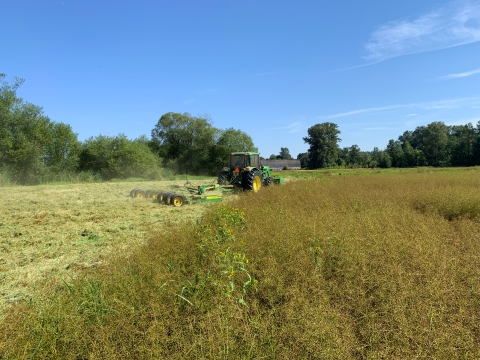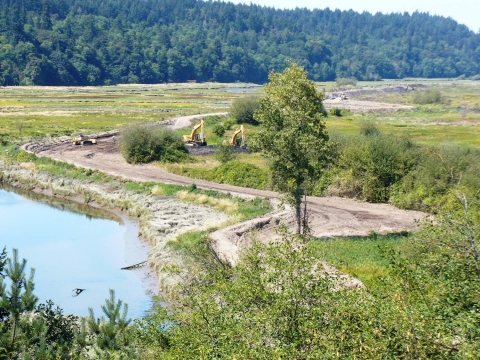What We Do
The National Wildlife Refuge System is a network of lands and waters managed by the U.S. Fish and Wildlife Service. Wildlife conservation is at the heart of the refuge system and drives everything we do from the establishment of the refuge, to the recreational activities we offer, to the resource management tools we deploy. Utilizing the right management tools helps us ensure the survival of local plants and animals and helps fulfill the purposes of the refuge.
Management and Conservation
The refuge uses a wide range of land management tools based on the best science available. The management methods and tools used are aimed at ensuring a balanced conservation approach where both wildlife and people will benefit.
Habitat Management
Billy Frank Jr. Nisqually Refuge provides important habitat for migratory and overwintering waterbirds. In 2008, a setback levee was constructed to create approximately 225 acres of freshwater wetlands. Management of the wetlands is prescriptive and scheduled according to season and the timing of bird use during migration, overwintering, and breeding periods. Water levels are drawn down to allow for mechanical treatments (mowing, plowing, disking) to control invasive plants, including reed canary grass, and promote more desirable plant growth. Mosaics of vegetation creates open water and emergent wetlands for a diversity of bird species. When completed, the ponds are flooded in time for fall migration when tens of hundreds of waterfowl stopover to feed and rest before continuing their journey north. Management actions to provide habitat and food resources for wildlife occurs in other habitats within the refuge, including riparian riparian
Definition of riparian habitat or riparian areas.
Learn more about riparian forest, permanent and seasonal wetlands, and upland forests.
Inventory and Monitoring
The Fish and Wildlife Service is responsible for monitoring the status and trends of fish, wildlife, and plants on refuges, An essential component of habitat management is documentation of treatments to evaluate the effectiveness of management actions, response of vegetation to treatments, and subsequent use by wildlife. Monitoring post-treatment leads to adapting our techniques the following year to meet our management goals. Invasive plants, especially those identified as noxious by Thurston and Pierce Counties, are monitored, mapped, and treated throughout the year to control the spread and encroachment on native species. Hydrological monitoring is conducted at the Black River Unit to better understand the seasonal availability of permanent water for federally-threatened Oregon spotted frogs and to aid in restoration planning.
Wildlife monitoring is conducted by Refuge staff and volunteers, for example: overwintering waterfowl surveys; Oregon spotted frog breeding; and invasive European green crabs,
Our Projects and Research
In 2009, in partnership with the Nisqually Indian Tribe and Ducks Unlimited, Inc., the largest estuary restoration project in the Pacific Northwest was completed with the removal of the century-old Brown Farm Dike in the Nisqually River Delta. The tides returned to 762 acres of estuary. The enhancement of freshwater wetlands diversifies available habitat and assists in the recovery of Puget Sound salmon and wildlife populations. Subsequent monitoring and research is documenting the changes over time and the benefits to fish and wildlife, both within the Delta and beyond in South Puget Sound.
Law Enforcement
In order to protect and maintain habitats and the wildlife they support, it's essential for visitors to follow rules and guidelines. Trail locations and access are designed to provide viewing experiences and guide visitors to areas with the least potential for wildlife disturbance. Fish and Wildlife law enforcement officers help visitors understand and obey refuge rules and wildlife protection laws.
Laws and Regulations
Billy Frank Jr. Nisqually National Wildlife Refuge protects, restores, and manages habitats for a diversity of wildlife species. There is a wide range of laws and regulations that guide our activities to maintain our mission and purpose. Other regulations are in place to ensure visitor opportunities will not have negative impacts on the habitats and wildlife we are here to protect.

